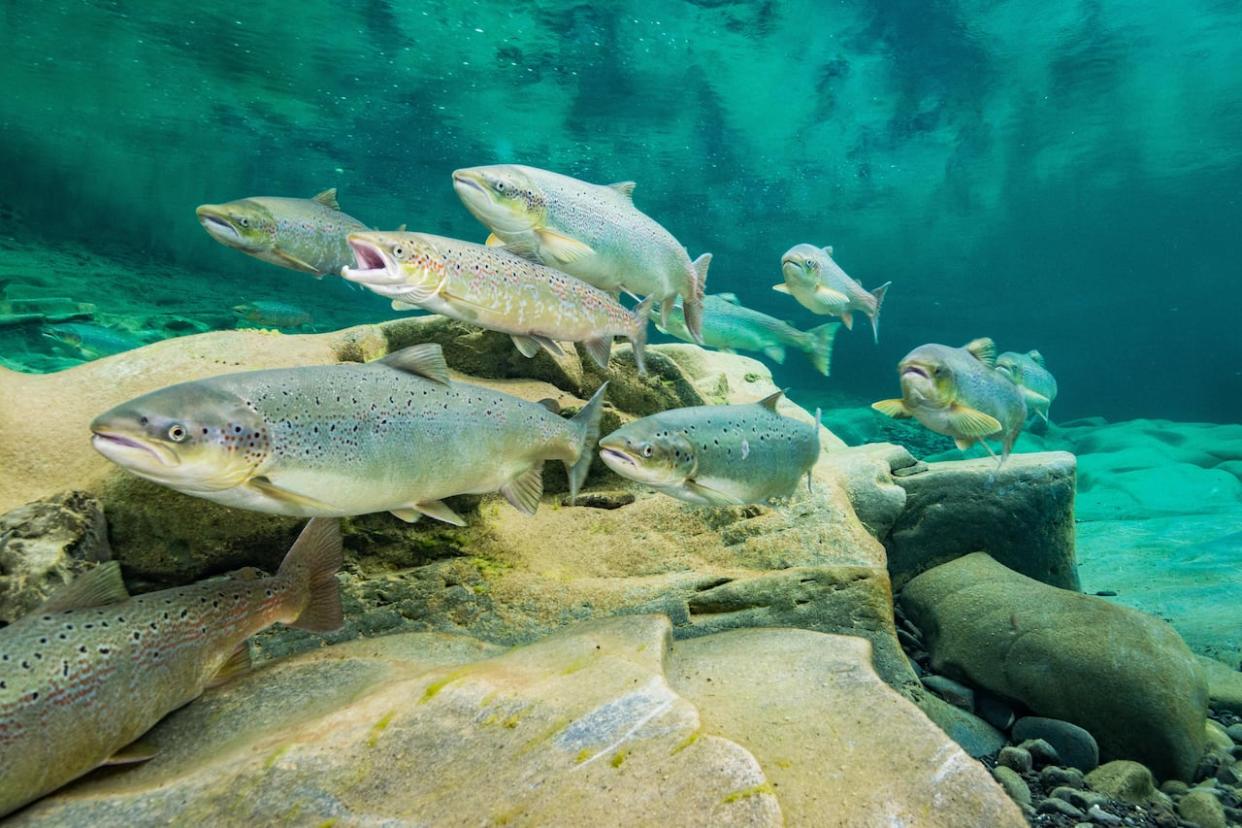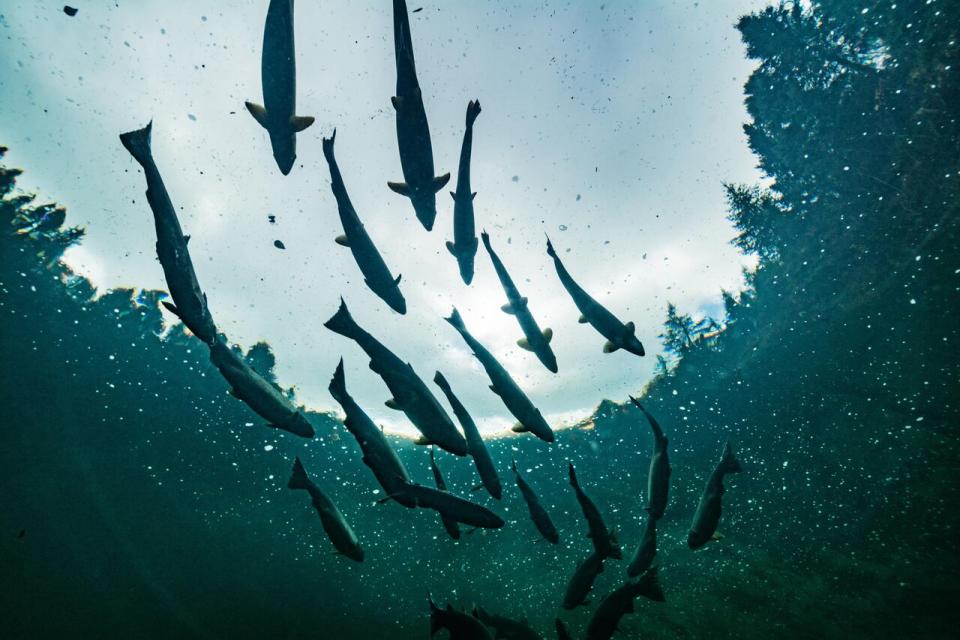Conne River salmon on the road to extinction, says DFO study, with aquaculture a leading factor


A new report says salmon in Newfoundland's Conne River are in danger of being wiped out and says aquaculture, along with climate change and predation, is a big factor in the fish's population decline. (Submitted by Nick Hawkins)
A new comprehensive review of Atlantic salmon in Conne River, on Newfoundland's south coast, says aquaculture operations are the biggest reason for the population decline — and if things don't change, the fish could be wiped out.
Travis Van Leeuwen, a Department of Fisheries and Oceans research scientist and co-author of the report, released in April, says the river had at least 10,000 large and small salmon, but since 2020 fewer than 300 adult salmon return to Conne River every year.
"It's really the magnitude of the decline that we're seeing in Conne River that's extremely concerning," Van Leeuwen told CBC News.
Marine cage culture of salmonids started in the mid-1980s at Bay d'Espoir and later expanded east into Fortune Bay. In 1992, Newfoundland and Labrador's commercial salmon fishery ended. But while the salmon population in rivers in other areas of the province bounced back, Conne River's continued to decline.
Several factors considered
Researchers looked at 19 possible factors causes of the decline. Most, such as commercial fishing in St-Pierre-et-Miquelon, habitat destruction, bycatch, poaching, pollution and recreational fishing were ruled out. The Miawpukek First Nation no longer fishes the river, and there has been no food, social and ceremonial fishery since 1998.
Van Leeuwen said the research found three main causes of the decline: the effects of aquaculture, climate change and predation. Aquaculture was deemed the most significant, as escaped farmed salmon breeding with wild salmon has been a major issue.
DFO research scientist Ian Bradbury has done extensive work on south coast rivers, including Conne River.
If more than one out of 10 salmon in a river is an escapee versus a wild salmon, Bradbury's work predicts the decline of the wild population.
In one study, 17 of 18 rivers had exceeded that threshold.
And farmed fish continue to escape and breed with wild salmon. Van Leeuwen says there's data on large-scale escapes that happened in 2013 and in every year from 2018 to 2021. But based on Bradbury's work he said, the amount of hybridization happening between escaped and wild salmon suggests other smaller-scale, called trickle losses.
"You would expect the amount of hybridization to reduce if those were really the only escape events that were occurring," he said.
Trickle losses
The study also notes sea lice is one of the greatest threats to wild Norwegian salmon, and Newfoundland also struggles with it, with outbreaks of sea lice on farms on the south coast.
Van Leeuwen said he doesn't think there's any doubt about whether such parasites and diseases affect wild populations.
"These outbreaks occur when smolt and adults are in the area of the aquaculture," he said. "To think that somehow they're not affected by this is, I think we're beyond that now. But quantifying the magnitude of these effects of pathogens and parasites on wild salmon populations is incredibly difficult."

In 1987, there were upwards of 10,000 salmon in Conne River. Today, only about 300 adult salmon return to the river each year to spawn. (Submitted by Nick Hawkins)
Report reaction
Bradley Benoit, chief of Miawpukek First Nation in Conne River, praised the report.
"Salmon has played a major part in our lives and our culture and history of the people of Miawpukek," he told CBC News. "We would love to see a sustainable salmon population and an appropriate balance with the industry, and we would welcome further science and research funding as a part of the ongoing efforts of our Natural Resources Guardian program."
Benoit says aquaculture brings a lot of work to Conne River.
"Aquaculture represents an industry here in rural Newfoundland where opportunities are few and we have to find a sustainable way to move forward involving all stakeholders."
Fisheries, Forestry and Agriculture Minister Elvis Loveless says he hasn't read the report but he's concerned to see the numbers are so low. He said he's skeptical aquaculture is the biggest factor.
"That can be debated, but we know climate change, seals — I've heard that from people that are down in the area that are contributing factors as well. So when they say aquaculture is the leading contributing factor to it, I would debate that."
Loveless says groups representing salmon anglers and the aquaculture industry should be at the table to find balanced solutions to the problem.
In an email, Jamie Baker, executive director of the Newfoundland Aquaculture Industry Association said there's "nothing new" in the report. He said the report relies on data 12 or more years old and "appears to understate the clear impacts of climate change and warming waters everyone is seeing in the marine environment."
"It is well established that salmon populations across the Atlantic have been in decline for decades, well before salmon farming started," he wrote. "In fact, salmon aquaculture can be considered a conservative approach to protecting wild salmon — whether by enhancing wild populations or supplying the increasing demand for healthy seafood."
Industry expansion ahead
The provincial government has been encouraging further expansion of the aquaculture industry, issuing call in 2020 for expressions of interest in Bays West, an area running west along the south coast from Grey River. Grieg Seafood Newfoundland was selected to expand operations in that area, with Mowi Canada East is looking to expand operations east of Grey River.
In light of plans to expand aquaculture in Newfoundland, say the report's authors, more studies are needed to investigate how endangered salmon populations will be affected by climate change and disease.
"Such data are critical to informing management approaches needed to reverse the decline of this population that is clearly on an extirpation trajectory," says the report.
Van Leeuwen says he hopes the paper raises the awareness "that Conne River deserves."
"And we can start getting targeted research efforts in place. Get all levels of government, industry, the [Miawpukek First Nation] all together and start having discussions related to Conne River and restoration strategies."

